
Precise edges at new record speed: New process significantly increases production capacity of battery electrodes. (Photo: Ralf Diehm, KIT)
30.07.2019/XNUMX/XNUMX - With a new coating process, a research team from the Karlsruhe Institute of Technology (KIT) has achieved the fastest production of electrodes for lithium-ion batteries to date. At the same time, the new process improves the quality of the electrodes and reduces production costs.
When manufacturing electrodes for batteries, electrode material is applied as a thin paste in a rectangular pattern on a sheet of copper or aluminum. Interrupted is the pattern of short sections of uncoated film, which are essential for the dissipation of electrons. For these sections, the coating process must be interrupted again and restarted. A particular challenge is to allow sharp edges without smearing the material at very high production speeds. "Electrode coating precision is a key factor in the efficiency and cost of battery cell production," says Professor Wilhelm Schabel of the Institute for Thermal Process Engineering - Thin Film Technology (TVT-TFT), who is responsible for research at KIT is. "Even small production errors make battery cells useless. Due to the high reject rate and the low throughput, lithium-ion batteries are more expensive today than they would actually require. "It is precisely this area that enables the highest cost savings in cell production, emphasizes Schabel.
Faster coating by means of membrane nozzle
The doctoral student Ralf Diehm made a decisive development in Schabel's group. He equipped and developed the nozzle for the electrode material with a vibrating membrane, which cyclically stops and restarts the application of the coating paste. "Because this membrane is much lighter than mechanical valves, very fast reaction times and therefore high speeds are possible," explains Diehm. "So far, manufacturers have been limited to speeds ranging from about 30 to 40 meters per minute. With the new technology, we can achieve up to 150 meters per minute in electrode coating. "In addition to higher production speeds, elimination of mechanical parts in the application nozzle has even more advantages for electrode production: Because the diaphragm can be controlled much more precisely than mechanical valves, it improves the manufacturing quality and rejects are reduced. The technology will now be transferred from the laboratory to industrial production as part of a spin-off of Ralf Diehm and his team.
Faster drying through systematic process optimization
In order for battery production to benefit from a faster electrode coating, the production process has to be readjusted elsewhere. Philip Scharfer, head of the Thin Film Technology (TFT) group at KIT, who has been working with Professor Schabel on this topic for many years. "A faster coating requires shorter drying times. Otherwise, the dryer section and thus the entire system would have to be increased accordingly. "On the basis of fundamental investigations of different drying conditions, a knowledge-based optimization of the drying process could already be carried out at KIT, which reduces the drying time by about 40 percent with constant electrode properties. In the research cluster ProZell II funded by the Federal Ministry of Education and Research (BMBF), this work is now to be continued together with partners from the Technical University of Braunschweig and the Center for Solar Energy and Hydrogen Research Baden-Württemberg (ZSW) in Ulm.
Research platform CELEST as a technology driver
Electrode production at record speed with high production quality at the same time enables considerable cost savings for cell production. A typical production line can produce electrodes for up to three times as many battery cells, thus helping to meet the growing demand for electric mobility. TFT develops its technologies for electrode production - also for future new material systems - as part of the Center for Electrochemical Energy Storage Ulm & Karlsruhe (CELEST), one of the world's largest research platforms in the field of battery research. New findings on production technology also flow directly into the Post Lithium Storage Excellence Cluster (POLiS), in which KIT is developing the batteries of the future together with Ulm University.
Details about the KIT Energy Center: http://www.energie.kit.edu External Link
As "The Research University in the Helmholtz Association", KIT creates and communicates knowledge for society and the environment. The aim is to make significant contributions to the global challenges in the fields of energy, mobility and information. 9 300 employees work together on a broad disciplinary basis in natural sciences, engineering, business, humanities and social sciences. His 25 100 students prepare KIT for responsible tasks in society, economy and science through a research-oriented university degree program. The innovation activity at KIT bridges the gap between knowledge and application for social benefit, economic prosperity and preservation of our natural livelihoods.
Further press contact:
Martin Heidelberger
Editor / Press Officer
Tel: + 49 721 608-21169
martin heidelberger∂kit edu
Photo: Ralf Diehm, KIT
